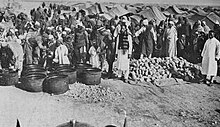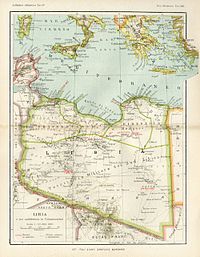Italian Cyrenaica
Italian Cyrenaica Cirenaica Italiana | |||||||||
|---|---|---|---|---|---|---|---|---|---|
| 1927–1934 | |||||||||
| Capital | Benghazi | ||||||||
| Common languages | Italian Arabic | ||||||||
| Religion | Islam Roman Catholicism | ||||||||
| Government | Colony | ||||||||
| Historical era | Interwar period | ||||||||
• Established | 1927 | ||||||||
• Disestablished | 1934 | ||||||||
| |||||||||

Italian Cyrenaica was an Italian colony, located in present-day eastern Libya, that existed from 1927 to 1934. It was part of the Italian North African territory conquered from the Ottoman Empire in 1911.
History
Italian Cyrenaica was formed in 1927, after it and Italian Tripolitania became independent colonial entities within Italian North Africa. In 1934, Italian Cyrenaica became part of Italian Libya.
In the 1920s, Cyrenaica was the scene of fighting between Italian colonial forces and Libyan rebels who were fighting for independence from colonial rule. In 1931, the rebel independence leader Omar Mukhtar was captured and executed.
Cyrenaica was populated by more than 20,000 Italian colonists in the late 1930s, mainly around the coast. As a consequence there was a large economic development effort in the second half of the 1930s. Italy did massive investment in the infrastructure of Libya but the purpose was to develop the economy for the benefit of Italy.[1]
The Italian aim was to drive the local population to the marginal land in the interior and to resettle the Italian population in the most fertile lands of Libya.[2] The Italians did not provide the Libyans with adequate education, the Italian population (about 10% of the total population) had 81 elementary schools in 1939-1940, while the Libyans (more than 85% of total population) had 97.[3]
In Cirenaica were founded -for the Italian colonists- the rural villages of Baracca, Maddalena, Oberdan, D’Annunzio and Battisti in 1938, successively Mameli and Filzi in 1939. For Libyan families (who contributed with many soldiers enrolled in the two Italian-Libyan Divisions: 1st Libyan Division Sibelle and 2 Libyan Division Pescatori) were created in Cyrenaica the villages of Gedida-Nuova, Nahida-Risorta, Zahra- Fiorita and el-Fager-Alba.
Italian concentration camps in Cyrenaica

Fascist Italy maintained several concentration camps in Eastern Libya during the first phase of its occupation of that country. The colonial administration began in 1929 the nearlywholesale deportation of the people of the Jebel Akhdar to deny the rebels the support of the local population. The forced migration of more than 100,000 people ended in concentration camps in Suluq, El Magrun, Abyar and El Agheila where tens of thousands died in squalid conditions, mainly because of epidemies like the Spanish flu.The concentration camps were dismantled after 1934, when the fascist regime obtained full control of the area and started a policy of assimilation of the local arab community. This policy was so successful that in 1940 there were two Italian colonial division made of Libyans.
Infrastructure

The Italians implemented major infrastructure projects in Italian Cyrenaica, mainly in the 1930s; the most important were the coastal road between Tripoli and Benghazi, the railways Benghazi-Barce and Benghazi-Soluch, and the enlargement of the Port of Benghazi.
A group of villages with all the needed communications (and infrastructures) for Italians and Libyans were established in coastal Cyrenaica during the 1930s.[4]
Notes
- ^ General History of Africa, Albert Adu Boahen,Unesco. International Scientific Committee for the Drafting of a General History of Africa, page 196, 1990
- ^ General History of Africa, Albert Adu Boahen,Unesco. International Scientific Committee for the Drafting of a General History of Africa, page 196, 1990
- ^ General History of Africa, Albert Adu Boahen,Unesco. International Scientific Committee for the Drafting of a General History of Africa, page 196, 1990
- ^ Template:It icon Chapter Libya-Cyrenaica
Bibliography
- Chapin Metz, Hellen. Libya: A Country Study. Washington: GPO for the Library of Congress, 1987.
- Sarti, Durand. The Ax within: Italian Fascism in Action. Modern Viewpoints. New York, 1974.
See also
- Italian Libya
- Italian Libya Railways
- Italo-Libyans
- Italian concentration camps in Libya
- Jebel Akhdar Mountains
- Benghazi Province




